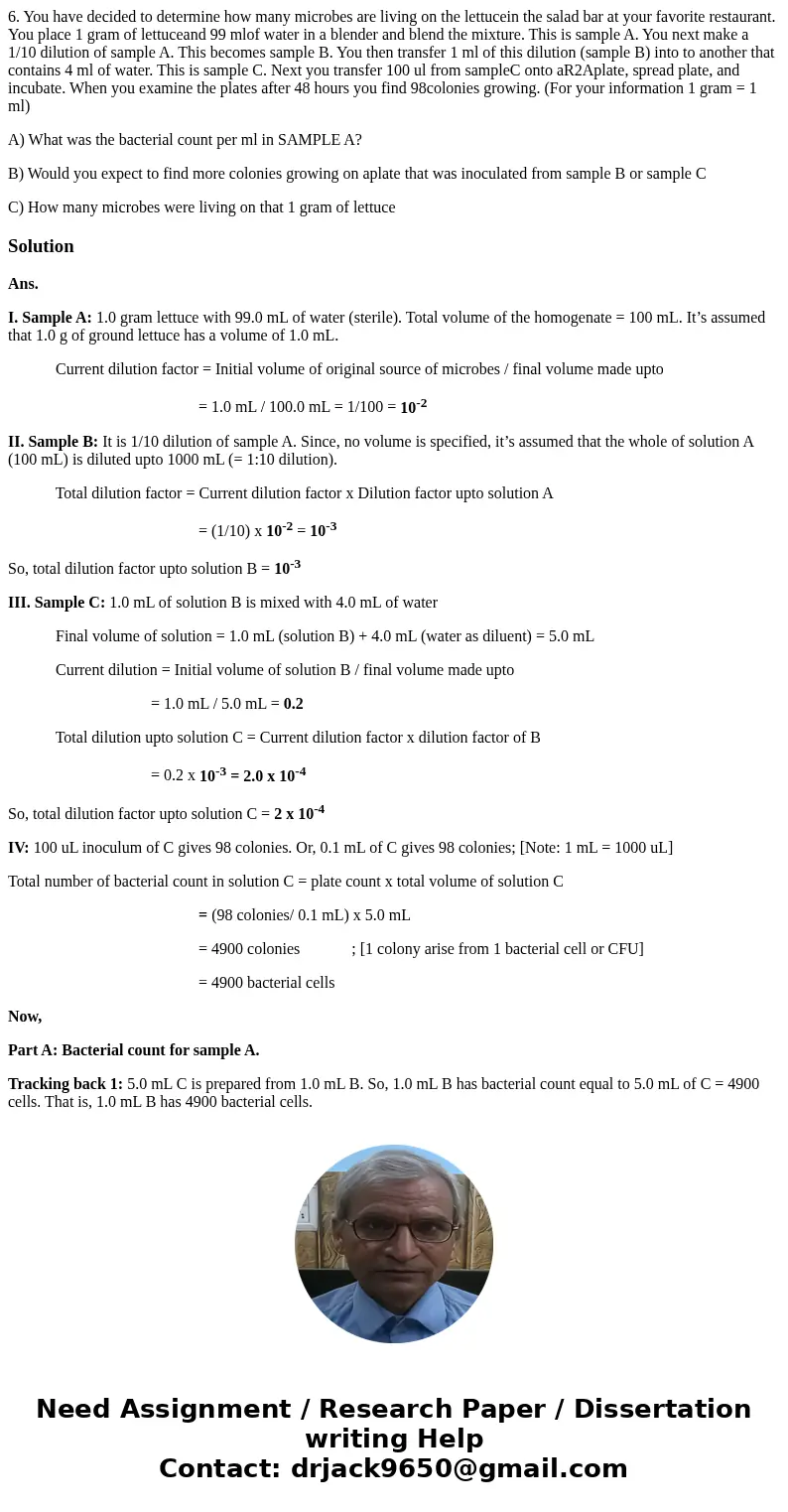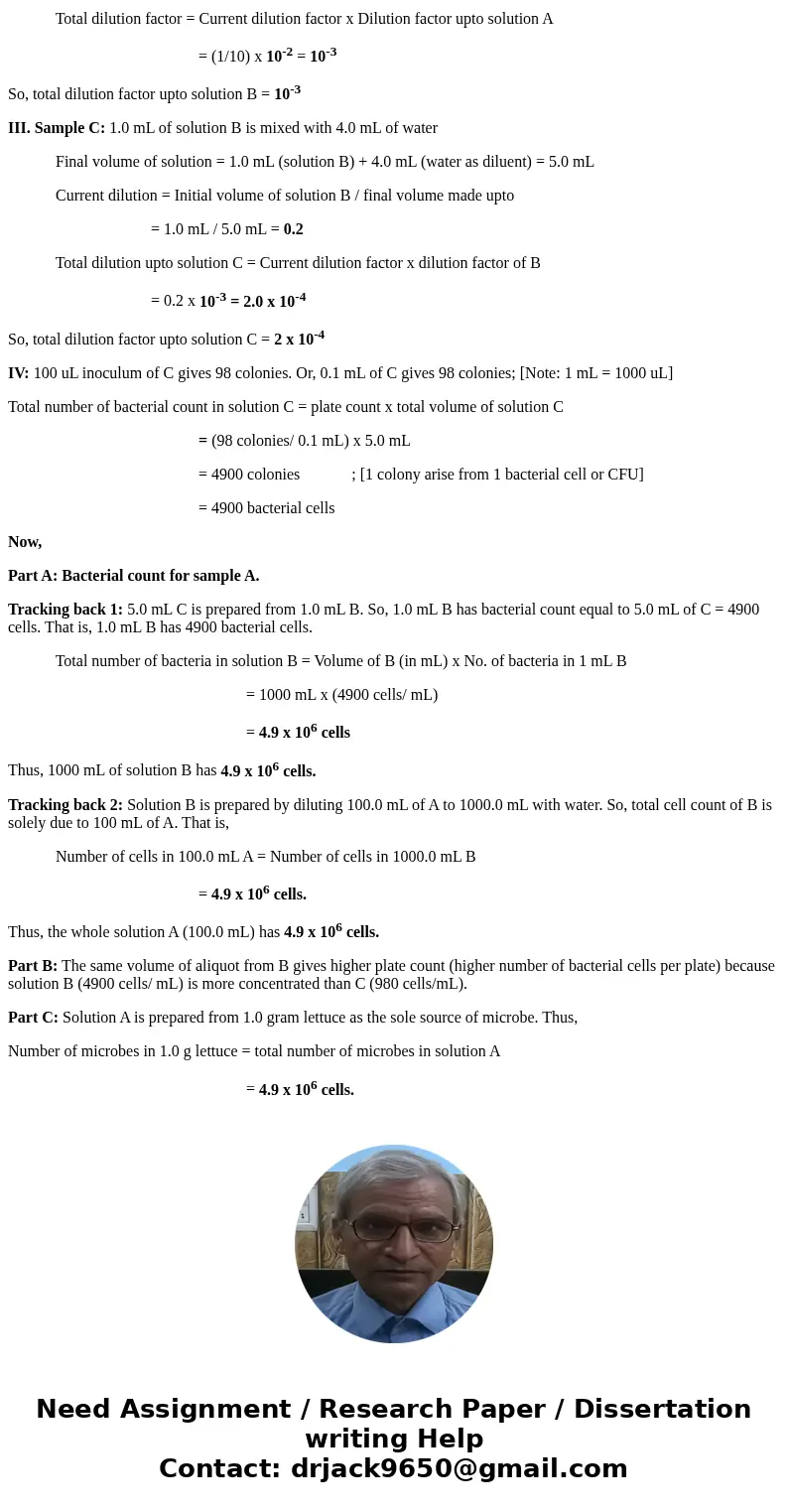6 You have decided to determine how many microbes are living
6. You have decided to determine how many microbes are living on the lettucein the salad bar at your favorite restaurant. You place 1 gram of lettuceand 99 mlof water in a blender and blend the mixture. This is sample A. You next make a 1/10 dilution of sample A. This becomes sample B. You then transfer 1 ml of this dilution (sample B) into to another that contains 4 ml of water. This is sample C. Next you transfer 100 ul from sampleC onto aR2Aplate, spread plate, and incubate. When you examine the plates after 48 hours you find 98colonies growing. (For your information 1 gram = 1 ml)
A) What was the bacterial count per ml in SAMPLE A?
B) Would you expect to find more colonies growing on aplate that was inoculated from sample B or sample C
C) How many microbes were living on that 1 gram of lettuce
Solution
Ans.
I. Sample A: 1.0 gram lettuce with 99.0 mL of water (sterile). Total volume of the homogenate = 100 mL. It’s assumed that 1.0 g of ground lettuce has a volume of 1.0 mL.
Current dilution factor = Initial volume of original source of microbes / final volume made upto
= 1.0 mL / 100.0 mL = 1/100 = 10-2
II. Sample B: It is 1/10 dilution of sample A. Since, no volume is specified, it’s assumed that the whole of solution A (100 mL) is diluted upto 1000 mL (= 1:10 dilution).
Total dilution factor = Current dilution factor x Dilution factor upto solution A
= (1/10) x 10-2 = 10-3
So, total dilution factor upto solution B = 10-3
III. Sample C: 1.0 mL of solution B is mixed with 4.0 mL of water
Final volume of solution = 1.0 mL (solution B) + 4.0 mL (water as diluent) = 5.0 mL
Current dilution = Initial volume of solution B / final volume made upto
= 1.0 mL / 5.0 mL = 0.2
Total dilution upto solution C = Current dilution factor x dilution factor of B
= 0.2 x 10-3 = 2.0 x 10-4
So, total dilution factor upto solution C = 2 x 10-4
IV: 100 uL inoculum of C gives 98 colonies. Or, 0.1 mL of C gives 98 colonies; [Note: 1 mL = 1000 uL]
Total number of bacterial count in solution C = plate count x total volume of solution C
= (98 colonies/ 0.1 mL) x 5.0 mL
= 4900 colonies ; [1 colony arise from 1 bacterial cell or CFU]
= 4900 bacterial cells
Now,
Part A: Bacterial count for sample A.
Tracking back 1: 5.0 mL C is prepared from 1.0 mL B. So, 1.0 mL B has bacterial count equal to 5.0 mL of C = 4900 cells. That is, 1.0 mL B has 4900 bacterial cells.
Total number of bacteria in solution B = Volume of B (in mL) x No. of bacteria in 1 mL B
= 1000 mL x (4900 cells/ mL)
= 4.9 x 106 cells
Thus, 1000 mL of solution B has 4.9 x 106 cells.
Tracking back 2: Solution B is prepared by diluting 100.0 mL of A to 1000.0 mL with water. So, total cell count of B is solely due to 100 mL of A. That is,
Number of cells in 100.0 mL A = Number of cells in 1000.0 mL B
= 4.9 x 106 cells.
Thus, the whole solution A (100.0 mL) has 4.9 x 106 cells.
Part B: The same volume of aliquot from B gives higher plate count (higher number of bacterial cells per plate) because solution B (4900 cells/ mL) is more concentrated than C (980 cells/mL).
Part C: Solution A is prepared from 1.0 gram lettuce as the sole source of microbe. Thus,
Number of microbes in 1.0 g lettuce = total number of microbes in solution A
= 4.9 x 106 cells.


 Homework Sourse
Homework Sourse